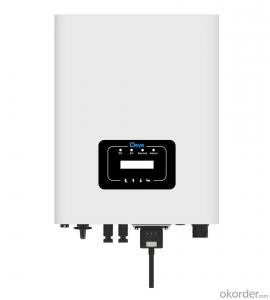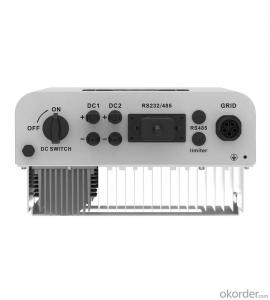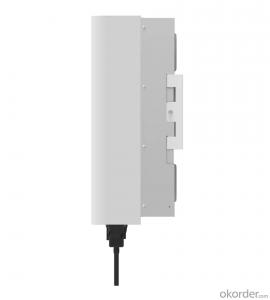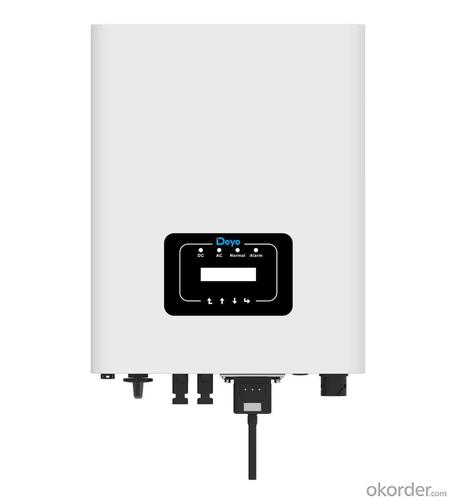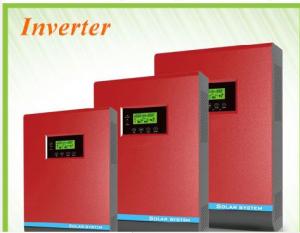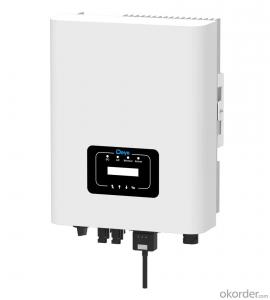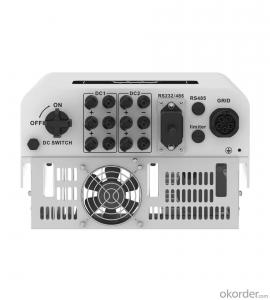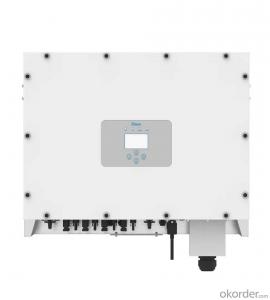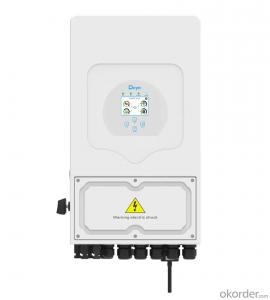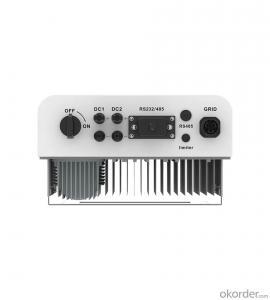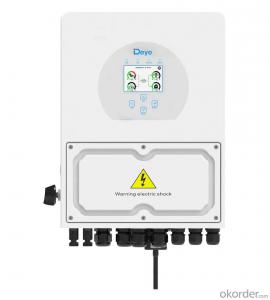SPD for Solar Inverter - Sun-4/5/6/7/8/10/12k-G05 | 4-12kW | Three Phase | 2 MPPT
- Loading Port:
- Ningbo
- Payment Terms:
- TT OR LC
- Min Order Qty:
- 100 pc
- Supply Capability:
- 5000 pc/month
OKorder Service Pledge
OKorder Financial Service
You Might Also Like
Specification
| Technical Data | |||||||||
| Model | SUN-4K-G05 | SUN-5K-G05 | SUN-6K-G05 | SUN-7K-G05 | SUN-8K-G05 | SUN-10K-G05 | SUN-12K-G05 | ||
| Input Side | |||||||||
| Max. DC Input Power (kW) | 5.2 | 6.5 | 7.8 | 9.1 | 10.4 | 13 | 15.6 | ||
| Max. DC Input Voltage (V) | 1000 | ||||||||
| Start-up DC Input Voltage (V) | 140 | 250 | |||||||
| MPPT Operating Range (V) | 120~850 | 200~850 | |||||||
| Max. DC Input Current (A) | 13+13 | ||||||||
| Max. Short Circuit Current (A) | 19.5+19.5 | ||||||||
| No.of MPP Trackers | 2 | ||||||||
| No.of Strings per MPP Tracker | 1 | ||||||||
| Output Side | |||||||||
| Rated Output Power (kW) | 4 | 5 | 6 | 7 | 8 | 10 | 12 | ||
| Max. Active Power (kW) | 4.4 | 5.5 | 6.6 | 7.7 | 8.8 | 11 | 13.2 | ||
| Nominal Output Voltage / Range (V) | 3L/N/PE 380V/0.85Un-1.1Un, 400V/0.85Un-1.1Un | ||||||||
| Rated Grid Frequency (Hz) | 50 / 60 (Optional) | ||||||||
| Operating Phase | Three phase | ||||||||
| Rated AC Grid Output Current (A) | 5.8 | 7.2 | 8.7 | 10.1 | 11.6 | 14.5 | 17.4 | ||
| Max. AC Output Current (A) | 6.4 | 8 | 9.6 | 11.1 | 12.8 | 15.9 | 19.1 | ||
| Output Power Factor | 0.8 leading to 0.8 lagging | ||||||||
| Grid Current THD | <3% | ||||||||
| DC Injection Current (mA) | <0.5% | ||||||||
| Grid Frequency Range | 47~52 or 57~62 (Optional) | ||||||||
| Efficiency | |||||||||
| Max. Efficiency | 98.3% | ||||||||
| Euro Efficiency | 97.5% | ||||||||
| MPPT Efficiency | >99% | ||||||||
| Protection | |||||||||
| DC Reverse-Polarity Protection | Yes | ||||||||
| AC Short Circuit Protection | Yes | ||||||||
| AC Output Overcurrent Protection | Yes | ||||||||
| Output Overvoltage Protection | Yes | ||||||||
| Insulation Resistance Protection | Yes | ||||||||
| Ground Fault Monitoring | Yes | ||||||||
| Anti-islanding Protection | Yes | ||||||||
| Temperature Protection | Yes | ||||||||
| Integrated DC Switch | Yes | ||||||||
| Remote software upload | Yes | ||||||||
| Remote change of operating parameters | Yes | ||||||||
| Surge protection | DC Type II / AC Type II | ||||||||
| General Data | |||||||||
| Size (mm) | 330W×457H×185D | 330×457×205 | |||||||
| Weight (kg) | 10 | 11 | |||||||
| Topology | Transformerless | ||||||||
| Internal Consumption | <1W (Night) | ||||||||
| Running Temperature | -25~65℃, >45℃ derating | ||||||||
| Ingress Protection | IP65 | ||||||||
| Noise Emission (Typical) | <30 dB | ||||||||
| Cooling Concept | Natural cooling | ||||||||
| Max. Operating Altitude Without Derating | 2000m | ||||||||
| Warranty | 5 years | ||||||||
| Grid Connection Standard | CEI 0-21, VDE-AR-N 4105, NRS 097, IEC 62116, IEC 61727, G99, G98, VDE 0126-1-1, RD 1699, C10-11 | ||||||||
| Operating Surroundings Humidity | 0-100% | ||||||||
| Safety EMC / Standard | IEC/EN 61000-6-1/2/3/4, IEC/EN 62109-1, IEC/EN 62109-2 | ||||||||
| Features | |||||||||
| DC Connection | MC-4 mateable | ||||||||
| AC Connection | IP65 rated plug | ||||||||
| Display | LCD1602 | ||||||||
| Interface | RS485/RS232/Wifi/LAN | ||||||||
· 2 MPP tracker, Max. efficiency up to 98.3%
· Zero export application, VSG application
· String intelligent monitoring (optional)
· Wide output voltage range
· Anti-PID function (Optional)
SUN-4/5/6/7/8/10/12K-G05 | 4-12KW | Three Phase | 2 MPPT
Higher yields / Safe & Reliable / Smart / User-friendly
This series inverter is specially designed for three-phase PV systems, covering a wide power range of 4kW, 5kW, 6kW, 7kW, 8kW, 10kW, 12kW. With compactness design, it is easy to install and operate. It supports wide AC output voltage to ensure longer working hour.
- Q: How does a solar inverter handle harmonics in the grid?
- A solar inverter handles harmonics in the grid by incorporating filters and control algorithms that mitigate the impact of harmonics. These filters help in reducing the distortion caused by harmonics, ensuring that the solar inverter operates efficiently and does not introduce additional harmonics into the grid. The control algorithms continuously monitor the grid's harmonics and adjust the inverter's output accordingly to maintain compliance with the grid's harmonic standards.
- Q: What are the installation requirements for a solar inverter?
- The installation requirements for a solar inverter typically include a stable mounting surface, proper ventilation and clearance space, a compatible electrical connection, and compliance with local building codes and regulations. Additionally, the solar inverter should be installed in a location that receives adequate sunlight for efficient operation.
- Q: What is the role of an anti-islanding function in a solar inverter?
- The role of an anti-islanding function in a solar inverter is to ensure the safety of utility workers and prevent damage to the grid. It detects when there is a loss of connection to the grid and immediately shuts down the inverter, preventing it from continuing to supply power to the grid during a power outage. This is crucial because it prevents a potential dangerous situation called islanding, where the inverter continues to generate power and creates a false grid, posing risks to utility workers who may be working on the grid. By shutting down the inverter during an outage, the anti-islanding function helps maintain the stability and integrity of the electrical grid.
- Q: Can a solar inverter be used with solar-powered desalination systems?
- Yes, a solar inverter can be used with solar-powered desalination systems. Solar inverters are essential components in solar power systems as they convert the direct current (DC) electricity generated by solar panels into alternating current (AC) electricity that can be used to power various devices, including desalination systems. By connecting the solar panels to a solar inverter, the generated solar energy can be efficiently utilized to power the desalination system, making it a sustainable and environmentally friendly solution for producing fresh water.
- Q: Can a solar inverter be used in systems with different module efficiencies?
- Yes, a solar inverter can be used in systems with different module efficiencies. Solar inverters are designed to convert the DC power generated by solar modules into AC power that can be used in the electrical grid or for consumption. They are generally compatible with a wide range of module efficiencies and can efficiently handle different power outputs from the solar panels. However, it is important to ensure that the inverter's power rating matches the system's total power output to ensure optimal performance and efficiency.
- Q: Are there any safety concerns associated with solar inverters?
- Yes, there are some safety concerns associated with solar inverters. One of the primary concerns is the risk of electrical shocks or fires due to faulty installation or maintenance of the inverter. Additionally, some inverters may generate heat during operation, and if not properly ventilated, it can pose a fire hazard. It is crucial to follow proper installation guidelines, regularly maintain the inverter, and hire qualified professionals to minimize these safety risks.
- Q: Can a solar inverter be used in regions with high levels of dust or debris?
- Yes, a solar inverter can be used in regions with high levels of dust or debris. However, it is important to regularly clean and maintain the inverter to prevent any potential issues caused by the accumulation of dust or debris, which could affect its efficiency and performance.
- Q: What is the maximum AC output current that a solar inverter can provide?
- The maximum AC output current that a solar inverter can provide depends on the specific model and capacity of the inverter. In general, it is determined by factors such as the maximum power rating and efficiency of the inverter, as well as the size and configuration of the solar photovoltaic (PV) system it is connected to.
- Q: How does the quality of the AC waveform affect the performance of a solar inverter?
- The quality of the AC waveform directly impacts the performance of a solar inverter. A poor quality waveform can introduce harmonics and distortions, leading to reduced efficiency, increased heat generation, and decreased overall performance of the inverter. It can also cause issues with the functioning of other electrical equipment connected to the inverter. Therefore, ensuring a high-quality and clean AC waveform is crucial for optimal performance and longevity of a solar inverter.
- Q: Can a solar inverter be used with a three-phase electrical system?
- Yes, a solar inverter can be used with a three-phase electrical system. In fact, many solar inverters are designed to work with three-phase systems. These inverters are capable of converting the direct current (DC) generated by the solar panels into alternating current (AC) that can be used by the three-phase electrical system.
Send your message to us
SPD for Solar Inverter - Sun-4/5/6/7/8/10/12k-G05 | 4-12kW | Three Phase | 2 MPPT
- Loading Port:
- Ningbo
- Payment Terms:
- TT OR LC
- Min Order Qty:
- 100 pc
- Supply Capability:
- 5000 pc/month
OKorder Service Pledge
OKorder Financial Service
Similar products
Hot products
Hot Searches
Related keywords
